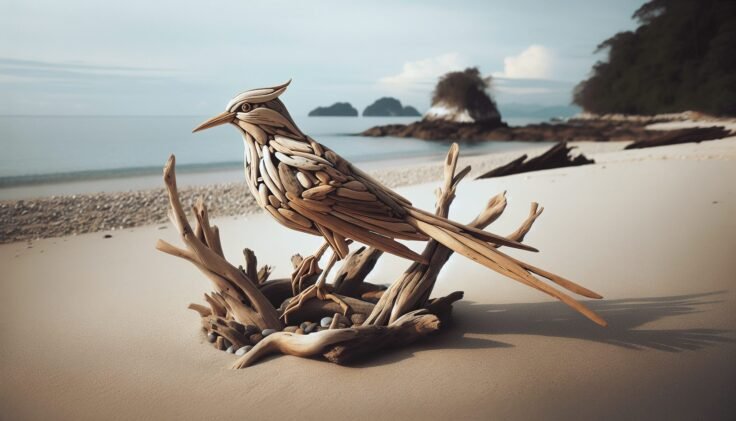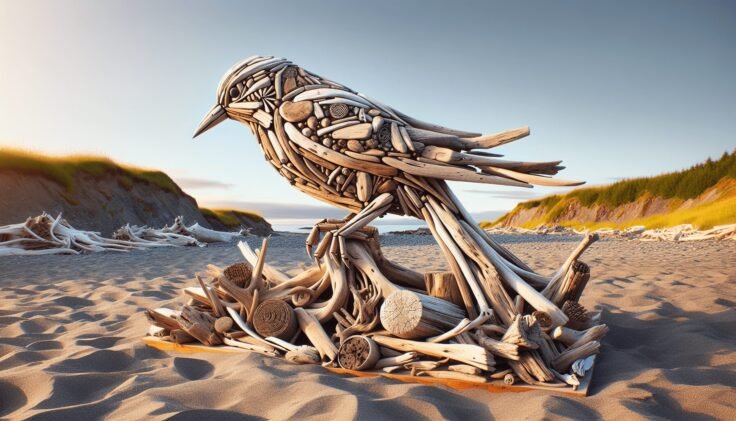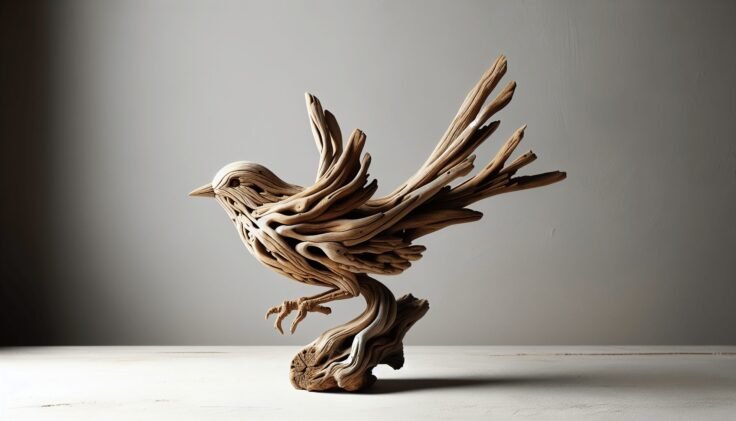Have you ever gazed upon a piece of art and marveled at how something so simple could capture the essence of nature so perfectly? Driftwood bird sculptures are one such enchanting form of art. These unique sculptures transform the otherwise unremarkable pieces of driftwood into lifelike representations of birds, capturing their grace and beauty. In the following sections, let’s explore the enchanting world of driftwood bird sculptures, from their origins to the techniques used in creating them, and even how you might create one of these captivating pieces yourself.
Origins of Driftwood Bird Sculpture
The art of sculpting using driftwood has roots in various cultures across the globe. Driftwood, shaped by nature’s elements, offers a unique medium that artists have long admired for its natural beauty and forms. Let’s discuss how this art form evolved into the specific creation of bird sculptures.
The Appeal of Driftwood
Driftwood’s allure lies in its history and transformation. Each piece of driftwood is unique, shaped by the forces of water, sand, and wind over time. This natural morphing gives each piece character and texture, making it an intriguing medium for artists. Its organic nature allows artists to visualize and carve different forms, including birds, making it a favored choice for many seeking to capture the essence of nature’s grace.
Cultural Significance
Different cultures have attached significant meanings to driftwood, viewing it as a symbol of resilience and adaptability. Driftwood art has been prevalent among coastal communities, where the materials are readily available. Over time, the sculpting of birds specifically has become popular, as birds are often symbolic of freedom and transcendence.
The Artistry Behind Driftwood Bird Sculptures
Creating a driftwood bird sculpture involves not just skill but also an eye for natural beauty. Artists must see beyond the raw form of driftwood and envision the majestic birds that can be brought to life from them. Here’s how these artists harness their creativity through different stages.
Selecting the Right Driftwood
The process begins with selecting the appropriate pieces of driftwood. Artists often spend considerable time finding pieces with the right size, shape, and texture. It’s important because the natural curves and lines of the driftwood play a significant role in representing the bird’s body, wings, and other features accurately.
Shaping and Sculpting
Once the perfect pieces of driftwood are selected, artists begin the intricate task of shaping and assembling them into bird forms. This process involves careful carving and smoothing of the wood to highlight the natural features that emulate a bird’s anatomy. Tools used can range from simple hand tools to more advanced equipment, depending on the intricate details needed.
Final Touches and Finishing
After shaping the driftwood into a bird, artists apply finishing touches to enhance the sculpture’s appearance. This step may involve sanding the wood to achieve a smooth texture and applying sealants or oils to protect the piece and bring out the rich colors and grains of the wood.

Popular Styles and Techniques
Driftwood bird sculptures vary greatly depending on an artist’s interpretation and technique. Here are a few notable styles and methods used by sculptors to bring these birds to life.
Realistic Sculptures
These sculptures aim to create lifelike representations of birds, paying close attention to details like feathers, eyes, and posture. Artists might study actual birds or photographs to ensure accuracy in proportion and anatomy.
Abstract Interpretations
Some artists prefer a more abstract approach, focusing on capturing the spirit or essence of a bird rather than an exact replica. This style might feature exaggerated forms or minimalistic details that play with viewers’ perceptions and evoke different emotions.
Mixed Media Techniques
Incorporating other materials like metal, stone, or glass can add another layer of depth to driftwood sculptures. These mixed media techniques allow artists to explore different textures and contrasts, which can augment the driftwood’s natural beauty.
How to Create Your Own Driftwood Bird Sculpture
While driftwood bird sculptures can sound daunting to create, with patience and creativity, you can craft your replica of this elegant art form. Here’s a step-by-step guide to starting your project.
Gather Materials
First, you’ll need to collect driftwood. Visit coastal areas, riverbanks, or lakeshores where driftwood naturally accumulates. It’s also important to gather tools like a carving knife, sandpaper, wood glue, and protective finish.
Visualize and Plan
Before you start carving, envision the bird you want to create. A sketch can help guide the process and ensure you stay on track. Consider the size and type of bird, and how the driftwood pieces can emulate its form.
Assemble and Sculpt
Begin with larger pieces for the bird’s body and wings. Use smaller pieces to add details like the beak and feathers. During the sculpting phase, slowly shape the driftwood, making sure you maintain its natural character while creating the desired form. Use wood glue to attach pieces securely.
Finishing Touches
After assembling, revisit your sculpture with sandpaper to smooth any rough edges. Apply a wood finish or sealant to protect the wood and enhance its hues. Allow sufficient time for the finish to dry.

Benefits of Driftwood Bird Sculptures
Aside from their aesthetic appeal, driftwood bird sculptures offer several benefits, both personally and environmentally.
Environmental Sustainability
Driftwood bird sculptures are an eco-friendly art form. By repurposing naturally discarded wood, artists contribute to sustainable practices and reduce demand for newly sourced wood.
Engaging Hobby
Creating these sculptures can be a fulfilling hobby that taps into your creativity and provides a sense of accomplishment. It allows one to engage in a mindful, hands-on activity that can be both relaxing and rewarding.
Unique Decor Piece
Driftwood bird sculptures make unique, nature-inspired additions to any home or garden. They often serve as conversation starters, reflecting both the artist’s skill and a respect for natural beauty.
Recognizing Talented Driftwood Artists
Several artists have gained accolades for their work with driftwood, creating standout pieces that capture both imagination and natural splendor. Here’s a glimpse into the work of some talented driftwood sculptors.
| Artist Name | Notable Works | Unique Style |
|---|---|---|
| James Doran-Webb | Lifecycle Series | Known for large, dynamic sculptures reflecting life stages |
| Debra Bernier | Spirit of Nature Pieces | Combines driftwood with clay to create ethereal creations |
| Jeffro Uitto | Wildlife Compositions | Focuses on intricate, life-sized animal sculptures |
These artists often draw inspiration from their surroundings, displaying a profound connection to nature that is evident in their work.
Appreciating Driftwood Bird Sculptures
To truly appreciate driftwood bird sculptures, one must acknowledge both the natural and artistic elements that make them unique. This appreciation involves recognizing the intricate process artists undertake to turn raw materials into expressive forms of avian art.
Understanding the Art
By familiarizing yourself with the processes and techniques involved, you can deepen your appreciation for this art form. Recognizing the skill behind the sculpting helps elevate these sculptures from mere decorative items to true masterpieces.
Visit Exhibitions and Galleries
Many galleries host exhibitions dedicated to driftwood art and sculpture. Visiting these can provide insight into different artists’ interpretations and techniques, further your understanding, and inspire your creative endeavors.
Collecting Driftwood Art
For those enamored by driftwood bird sculptures, building a collection can be a rewarding pursuit. Consider starting with pieces that resonate with you personally, made by artists whose work you admire and whose pieces speak to your aesthetic sensibilities.
Conclusion
Driftwood bird sculptures seamlessly blend art with nature, bringing to life the majestic flight of birds through carefully crafted pieces of driftwood. Whether you admire them for their artistic value or wish to create your own, this art form offers limitless inspiration and a unique way to connect with nature. Through exploration of history, techniques, and personal creativity, you can appreciate the serene beauty and craftsmanship of these amazing works of art, allowing them to add grace to your space or inspire your next project.



